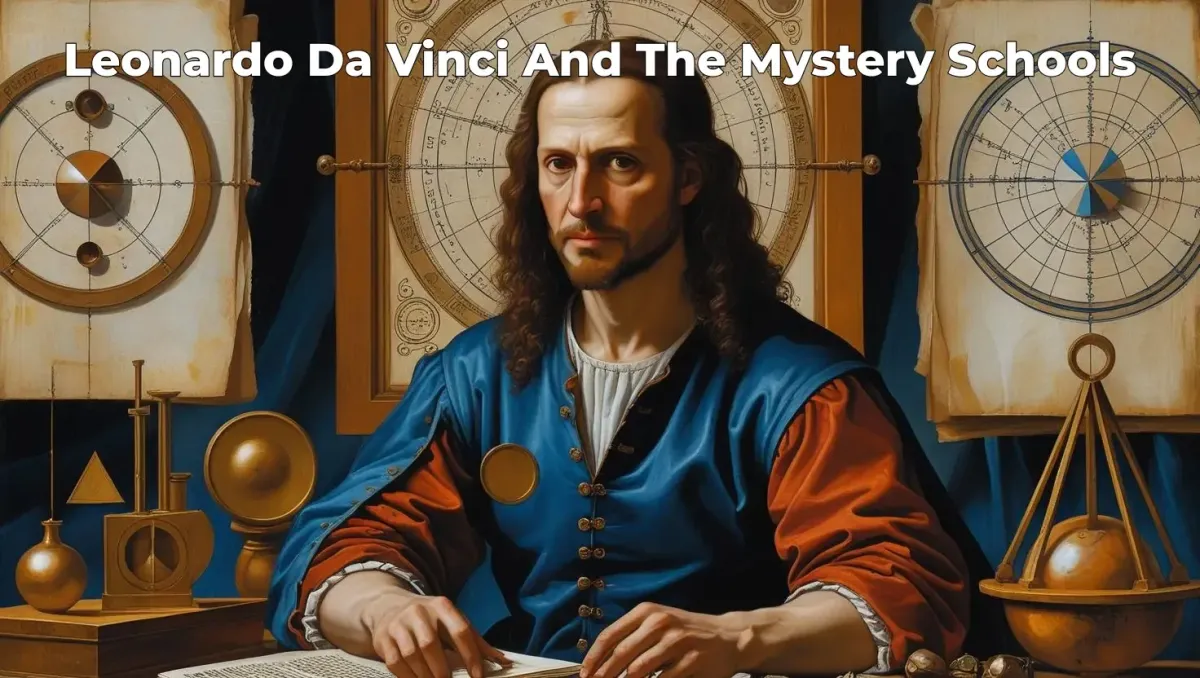
Leonardo da Vinci and the Secret Codes of the Mystery Schools
Leonardo da Vinci is often remembered as the quintessential “Renaissance man” — painter, inventor, anatomist, and visionary. Yet beneath the surface of his scientific genius and artistic brilliance lies another dimension: Leonardo as an initiate of mystery school wisdom.
Through his use of sacred geometry, symbolism, and hidden codes, da Vinci embedded esoteric knowledge into his works. His art was not merely aesthetic; it was a vehicle for unveiling universal truths, echoing the ancient teachings of the mystery schools.
New to mystery schools? Start with our overview article “What Are Mystery Schools?” and then visit the Mystery School hub for classes, courses and next steps.

Leonardo the Polymath Seeker
Born in 1452 in Vinci, Italy, Leonardo’s genius spanned countless fields: anatomy, engineering, architecture, music, and mathematics. But more than a scientist or artist, Leonardo was a seeker. He was captivated by the patterns of nature, the mechanics of life, and the hidden correspondences between microcosm and macrocosm.
This holistic curiosity reflects the spirit of the mystery schools, which taught that truth is unified and revealed through symbols, numbers, and forms.
For more on this worldview, see Metaphysics & Ontology: Mystery Schools and the Nature of Reality.
Leonardo & Mystery Schools — what’s real vs myth (plain English)
Leonardo was a Renaissance polymath, not a card-carrying member of a secret order. His notebooks show a method rooted in close observation, drawing, experiment and comparative study across anatomy, botany, engineering and mapping. That is why curators and scholars emphasise his “see for yourself” approach, preserved in thousands of sheets and codices. Treat the “Da Vinci Code” style rumours as fiction; the documented record points to empirical enquiry, not hidden initiations. (rct.uk)
The notebooks (where to find them, what they prove)
Codex Atlanticus (Milan, Biblioteca Ambrosiana): the largest collection of Leonardo’s writings and drawings, spanning mechanics to maps — a window onto his working method. (Veneranda Biblioteca Ambrosiana)
Forster Codices (V&A, London): show mirror-written notes on hydraulics, proportion, weights, perpetual motion critiques, and more — everyday pages from a restless mind. (Victoria and Albert Museum)
Royal Collection (Windsor/Buckingham Palace): over 550 sheets conserved together since the 17th century, covering anatomy, geology, cartography and water studies. (rct.uk)
Codex Leicester: a compact set of studies (light, water, fossils, the moon), purchased at Christie’s in 1994; regularly loaned for public display. (Christie's)
Takeaway: the surviving notebooks demonstrate a unified programme of observation and drawing. That is the through-line — not evidence of secret doctrine. (rct.uk)
Mirror Writing — Why he did it (without the myth)
Leonardo annotates from right to left. Museums note that the simplest explanation is left-handedness and ease of writing, though secrecy is often suggested. Either way, the content is practical: measurements, sketches, marginalia, working notes — not cryptograms to hide cult teachings. (Victoria and Albert Museum)
Geometry, proportion & the big symbol
H2: Vitruvian Man — proportion, not “codes”
The famous drawing (Venice, Gallerie dell’Accademia) synthesises Roman architect Vitruvius with Leonardo’s own measurements. It is rarely displayed due to light sensitivity and conservation rules. Read it as a study in measure, ideal, and the body as microcosm, not a treasure map of esoteric secrets. (Gallerie dell'Accademia di Venezia)
Natural Magic vs Observation - his stance
Renaissance “occult philosophy” explored correspondences, astral harmonies and hidden properties. Leonardo, by contrast, prioritised experience. Contemporary historians even record his sharp scepticism toward alchemists who claimed to replicate nature. That doesn’t mean he never tinkered with materials; it means his north star was evidence. (sciencehistory.org)
Sacred Geometry in Leonardo’s Work
One of the strongest connections between Leonardo and the mystery schools is his use of sacred geometry. Like Pythagoras before him, Leonardo saw numbers and geometric forms as reflections of cosmic order (Pythagoras and the Mystery Schools: Numbers, Music, and Harmony).
In Vitruvian Man, Leonardo illustrated the harmony of the human body within the circle and square — symbols of heaven and earth.
In The Last Supper, the composition subtly encodes the Golden Ratio, guiding the viewer’s eye in a flow of balance and symmetry.
His notebooks reveal detailed studies of polyhedra and proportional systems, echoing Platonic and Pythagorean traditions.
For Leonardo, geometry was not abstract but sacred design — the hidden architecture of both art and life.
Hidden Codes and Symbolism
Leonardo’s paintings are also rich with symbolism and coded messages. While scholars debate their meaning, many believe he intentionally embedded esoteric knowledge into his works.
In The Last Supper, the grouping of apostles suggests symbolic numerology tied to the 12 signs of the zodiac.
In The Mona Lisa, the enigmatic smile and subtle background landscapes evoke mystery traditions of duality, balance, and the eternal feminine.
Leonardo’s fascination with mirrors (he often wrote in mirror script) echoes the Hermetic maxim, “As above, so below.”
These codes align with the mystery school tradition of concealing wisdom in plain sight, accessible only to those with the eyes to see.
For a deeper dive into symbolic concealment, see Esoteric Philosophy & Magic: The Secret Teachings of Mystery Schools.
Leonardo and Alchemy
Leonardo was also influenced by alchemy — both as a proto-science and as a spiritual metaphor (Alchemy and the Mystery Schools: The Inner Gold of Transformation).
His studies of transformation in nature — from water cycles to human anatomy — mirror the alchemical principle of transmutation.
The blending of opposites in his works reflects the alchemical pursuit of unity.
His obsession with light and shadow can be seen as an alchemical dialogue between spirit and matter.
For Leonardo, painting itself was an alchemical act: transmuting base pigments into radiant visions of universal truth.
Influence of Hermeticism
The Renaissance was marked by a revival of Hermetic thought, particularly through translations of the Corpus Hermeticum (The Hermetic Principles: Universal Laws of the Mystery Schools). Leonardo lived at the heart of this cultural flowering.
Though there is no direct evidence that Leonardo read Hermetic texts, his writings and works reflect Hermetic ideas:
Humanity as a microcosm of the universe.
Nature as a living, intelligent whole.
Knowledge as both rational and mystical, requiring intuition as well as observation.
These themes run through his art and scientific notes, positioning him firmly within the stream of Renaissance esotericism.
Leonardo and the Feminine Mysteries
Leonardo also honoured the feminine principle — a theme central to many mystery schools. His depictions of Mary, Madonna, and feminine figures in works like The Virgin of the Rocks suggest not just religious devotion but symbolic reverence for the divine feminine as a vessel of wisdom, intuition, and creative power.
This aligns with teachings on the balance of masculine and feminine energies found across esoteric traditions, from Kabbalah’s sefirot to alchemical unions of sun and moon.
For more on heart-centred traditions, see Compassion-Based Energy Work: Heart-Centred Alchemy in the Mystery Tradition.
A Man of Mystery
Leonardo’s private notebooks, filled with cryptic sketches, mirror writing, and speculative inventions, reflect his role as both scientist and initiate. His tendency to cloak his knowledge in code suggests a deliberate attempt to protect esoteric ideas from misuse or persecution — a practice common to mystery schools throughout history.
Legacy of Leonardo’s Mystery Codes
Leonardo da Vinci’s art continues to fascinate not only because of its beauty but because it invites us into deeper layers of meaning. He reminds us that:
Art is a spiritual language, capable of transmitting hidden truths.
Symbols and geometry are bridges between the visible and invisible.
The pursuit of knowledge is holistic, blending science, spirituality, and creativity.
His life was, in many ways, a mystery school in itself — a living demonstration of wisdom expressed through art, invention, and inquiry.
Safety & ethics — a quick note for modern seekers
Discernment first
Admire the symbolism; practise with care. Prefer teachers who show transparent pricing, realistic claims, and aftercare. Avoid pressure, secrecy-for-payment, or miracle promises. If your body says “not for me,” pause. (This aligns with our general “ethics and red flags” guidance.)
Next Steps On Your Mystery School Path
If this article spoke to you, don’t leave it as just an interesting idea. Take one gentle step to deepen the journey.
·Visit the Mystery School hub to see all classes and courses in one place.
·Explore Secrets of the Third Eye for a structured, step-by-step journey into inner sight and symbolic perception.
Continue reading with these related articles:
Sacred Geometry: Patterns of the Divine in Mystery School Teachings
What Are Mystery Schools? The Hidden Lineage of Ancient Wisdom
Choose the one that feels kindest and most alive for you right now, and let the work unfold at your own pace.

Leonardo da Vinci invites us to look beyond appearances and discover the sacred patterns woven into life itself. His legacy is a reminder that art, science, and spirituality are not separate but deeply interconnected.
At the Bright Beings Academy Mystery School, you can uncover teachings on sacred geometry, alchemy, Hermeticism, and more — the very traditions Leonardo encoded into his masterpieces.

FAQs on Leonardo da Vinci and the Mystery Schools
Was Leonardo part of a mystery school?
There’s no evidence for formal initiation. The surviving record shows a working artist-scientist whose method was observational and experimental, preserved across major public collections. (Victoria and Albert Museum)
What is sacred geometry in Leonardo’s art?
It refers to his use of ratios, proportions, and geometric forms — like the Golden Ratio — to express harmony and cosmic order.
Why did Leonardo write in mirror script?
Some suggest it was to protect his ideas, while others see it as a Hermetic symbol of reflection and hidden wisdom.
How does Leonardo connect to alchemy?
His exploration of transformation, unity, and light reflects the symbolic language of alchemy.
So why the “secret” rumours?
Mirror writing, a symbol-rich age, and modern fiction. Museum essays explain mirror writing in practical terms; the notebooks read as lab books, not ciphers. (Victoria and Albert Museum)
What exactly is the Codex Leicester?
A 72-page notebook focused on water, light and cosmology topics — auctioned by Christie’s in 1994 and now loaned periodically for exhibitions. (Christie's)
Does Vitruvian Man contain “hidden codes”?
It formalises proportion from Vitruvius plus Leonardo’s own observations. The drawing is housed in Venice and displayed only on strict conservation schedules. (Gallerie dell'Accademia di Venezia)
Did Leonardo practise alchemy?
He experimented with materials (pigments, binders, varnishes) like many artists. But sources note he was critical of alchemists’ grand claims, favouring nature and verifiable effects. (sciencehistory.org)
Further reading
Neoplatonism and Theurgy: The Simple Map Behind Western Mysticism
The Emerald Tablet and As Above, So Below: A Plain-English Explainer
Alchemy Stages: Nigredo to Rubedo — The Inner Transformation Map
How to Vet a Mystery School: Ethics, Fees, Promises & Red Flags
I look forward to connecting with you in my next post.
Until then, be well and keep shining.
Peter. :)
